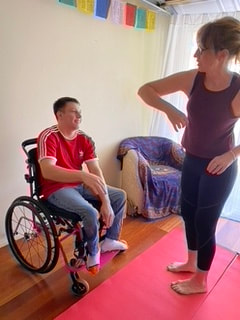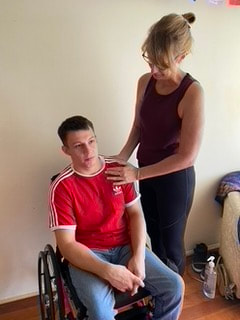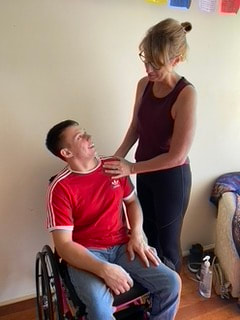What is Yoga Therapy and how is it different to a general yoga class?
Most commonly the queries around ‘what is yoga therapy?’ are questions pertaining to its differences to yoga. It’s important to clarify that whilst yoga therapy has a different structural approach that relate to the specific goals presented in the individual, yoga therapy is not outside of, nor larger, than yoga. Yoga Therapy sits within the complete system of yoga as a professionally-assisted modality, utilising the tools of yoga, for self-empowered redirection out of presenting issues. A necessary and key component of Yoga Therapy however, is the extensive individual assessment (pariksa) undertaken to understand the client’s individual condition before a specific practice – utilising any or all tools of yoga: asana, pranayama, chanting, mudra, bhanda etc - is prescribed for that person and that person alone. This element is crucial for those with specific conditions that are not catered to in a general yoga class.
The practice of Yoga Therapy draws from the principles of yoga and uses the full range of yoga practices.
Yoga Therapy empowers and supports individuals to manage their own health, teaching daily living skills, using the principles of yoga and incorporates a range of yogic tools explored within a professional therapeutic relationship with a Yoga Therapist.
Yoga Therapists have an understanding of western medical pathology, bio-medical knowledge and use their clinical skills to establish a professional relationship with the client/student. This is done in a clinical setting, initially one to one, which can continue within a small group setting should this be suitable to the participants needs.
Together, the therapist and client/student develop a self-empowering therapeutic program appropriate to the client/student’s individual needs. As a client/student walks their own specific path addressing their situation, they are guided by the Yoga Therapist with ongoing review, progress and assessment until the client/student is ready, with a good understanding of the tools at hand, to walk the path on their own.
This simple but comprehensive look at Yoga Therapy from IAYT:
https://cdn.ymaws.com/www.iayt.org/resource/resmgr/docs_c-iayt_tools/what_is_yoga_therapy/wyt_web_flier_2023.pdf
What are the root causes of unpleasant or painful symptoms?
Yoga Therapists undergo extensive training as a Post Grad to Yoga Teacher training to competently assess and support the individual directly as it applies to the individual in front of them however they may be presenting. Ill health and chronic injury are often compounded by multiple contributing factors. For this reason, Yoga Therapy engages in a holistic approach, encompassing the wellbeing of the whole person including the mental, physical, and emotional impact of any condition. In other words, Yoga Therapy targets the issues the client/student arrives with, as well as prior contributing factors.
The Yoga Therapy assessment is multifaceted, encompassing many areas of the individual’s life. It is with this assessment that the Yoga Therapist seeks to ascertain the core issue/s and causes that feed the presenting conditions including belief systems, lifestyle and other personal challenges to create highly individual practices that work hand in hand with the client/student’s own goals.
The techniques that a Yoga Therapist may utilise include asana (postures), pranayama (breath awareness and techniques), mudra (gestures), visualisations, chanting, relaxation, meditation, dietary advice, lifestyle counselling and self- development guidance. These practices are applied to ensure increased functional efficiency at all levels: physical, mental, and emotional using their knowledge of yogic and western physiology and pathology.
Yoga Therapy works with prana (vital life force and breath) and addresses the different mayam (mental, physical and emotional layers of the self), hand in hand with a knowledge of western medicine.
Due to its comprehensive nature, Yoga Therapy works as a supportive and complementary modality across the broadest spectrum of ailments; from addiction recovery, to spinal injuries, diabetes, insomnia, chronic pain, and cardiac conditions, to name a few.
'Yoga is the journey of the self, through the self, to the self' - The Bhagavad Gita
A Yoga Therapist guides the process of self-study (svadhyaya) so that the client/student can reach a deep place of self-understanding. In knowing themselves, the client/student becomes more empowered, and more refined in the maintenance and management of their own daily health needs.
Yoga Therapy aims to treat issues - in the form of any injury or illness at the physical, physiological and/or psychological levels - presenting at that moment in time, and sits within the complete system of yoga as a professionally assisted modality utilising the tools of yoga for self-empowerment, mind, body and spirit.
Yoga Therapy is most commonly provided by way of an individual consultation, although small therapeutic groups may be offered for those working toward a common goal. Yoga Therapy is an adjunct to other healthcare supports, and a Yoga Therapist is qualified to work as part of a multidisciplinary team to support the clients wellness.
Four steps of progression in Yoga Therapy:
1) Rest and Release
2) Functional Restoration
3) Strength Building
4) Empowerment of the Person
'If you can breathe you can do Yoga" T. Krishnamacharya
It is the role of the therapist to support and instruct the client/student to employ the techniques at their level of knowledge, capacity and wellbeing. Yoga Therapy by nature aims to meet the client/student where they are at - regardless of age, fitness, state of health, belief system or prior yoga experience. In this, Yoga Therapy is suitable for all people. No prior yoga experience is necessary to benefit from Yoga Therapy.
Although we are capable of working with all people, Yoga Therapists become more experienced and knowledgeable with different areas of support. See our Therapy page to see what we specialise in.
A Yoga Therapy session usually runs for 60 to 90 minutes. A student should expect to attend more than one session over several months which will ensure:
- a) that the techniques of practice are being executed in the best possible way
- b) they are working in the direction of the goal
- c) the practice progresses with the client/student
- d) the client/student progresses out of the issue
What Differentiates A Yoga Therapist from A Yoga Teacher?
A Yoga Therapist who is accredited at the highest industry standard as compiled and maintained by the AAYT, is a Yoga Teacher with a minimum of 350hr Certificated Yoga Teacher Training then has completed a further minimum of 2 years additional Yoga Therapy study in line with AAYT guidelines as well as practical mentoring and internship. IAYT Accredited Yoga Therapists have a more intensive requirement of study and experience. The further training enables a Yoga Therapist to work with the deeper knowledge required to support and or elicit change in clients/students with severe or mild illness or condition.
Acknowledgement to the writings and teachings of Sri Krishnamacharya as the founder of Yoga Therapy and to TKV Desikachar, Dr Natesan Chandrasekaran, Saraswathi Vasudevan and Gary Kraftsow from whom inspiration on themes and references are contained within this explanation. Lissie Turner and Ellen Nash co-authored an article which contains much of this information.





